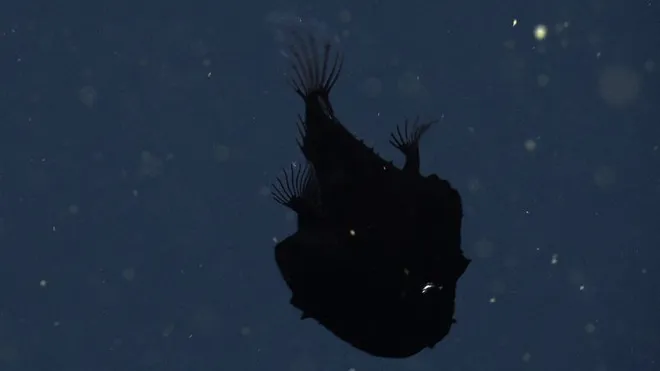Rare dreamer anglerfish with ultra-black 'invisibility cloak' spotted in California waters

A team of deep-sea explorers were recently scouring Monterey Bay off the coast of California when something strange and unexpected emerged in the distance.
On first glance, it appeared be a shadowy silhouette of a creature lurking in the depths of the Pacific Ocean. But the researchers with the Monterey Bay Aquarium Research Institute (MBARI) knew better.
What they were experiencing was a rare sighting of the dreamer anglerfish. The deep-sea creature is so black in color that its skin acts not unlike a literal "invisibility cloak," making it appear as little more than a shadow, the organization said in a recent news release.
Perhaps that camouflage is why sightings of the dreamer anglerfish don't happen every day. Well, that and the fact that the creature is known to mostly stick to depths too deep for humans to reach.
Researchers at the institute said they have encountered the dreamer anglerfish just nine times in 36 years of deep-sea exploration. The team's last sighting was in 2016.
"Coming upon a lurking anglerfish is an exciting experience for anyone exploring the deep water column,” Bruce Robison, a scientists at the institute who has conducted extensive research on deep-sea fishes, said in a statement.
Endangered frogs:More than 70 mountain yellow-legged frogs released in California lake
Dreamer anglerfish spotted during midwater expedition

The team's mission that day was to collect tiny spiked organisms known as phaeodarians.
The species is among those dwelling in the midwater region of the ocean that rely on a vital food source called marine snow, an organic material that sinks to deep ocean depths. Researchers had hoped to study their findings to better understand the link between Earth’s climate and the ocean.
But they weren't expecting to run into a creature as elusive as this species of anglerfish.
A remotely operated submersible that the researchers were piloting from land had descended to a depth of 781 meters (2,562 feet) in the Monterey Canyon when they first sighted the dreamer anglerfish lurking like a shadow.
The stealthy ambush predator had extended its luminescent lure from its head and appeared to be lying in wait for its prey. When a curious crustacean comes close, the anglerfish’s large jaws rapidly open wide and snap shut to trap a meal, the institute said.
As the deep-sea robotic vehicle moved closer, the fish stowed its lure away.
“The ‘invisibility cloak’ of this anglerfish is a good analogy for the many puzzles we have yet to fully understand about the ocean’s midwater," Crissy Huffard, who was chief scientist for the research cruise that encountered the dreamer anglerfish, said in a statement.
Strange mammal:Team led by Oxford biologist discovers long-lost echidna named for David Attenborough
Ultra-black skin of dreamer anglerfish absorbs all light
The scientists who first collected specimens of the sharp-toothed deep-sea anglerfish in the late 19th century thought it looked like something out of a dream, the institute said - too fantastical to be reality.
It's sharp teeth, luminous lure and ultra-black skin may more aptly be the stuff of nightmares, but researchers said its adaptations are crucial to ensuring its survival in an unforgiving environment.
Temperatures in the deep-sea, where no sunlight can reach and water pressure mounts, hover just above freezing. In the dark, desolate oceanscape, food can be just as hard to find as mates.
While many other species of fish at those depths have evolved dark coloration as camouflage, none are quite as dark as the dreamer anglerfish, the institute said. The dark coloration not only hides the fish from predators, but absorbs the light cast by its luminescent lure so prey cannot see it.
“Ultra-black skin ensures that any light that hits you, even the bright light from your own streetlamp-like lure, is completely absorbed," Karen Osborn, a research zoologist at the Smithsonian National Museum of Natural History, said in a statement. "Nothing reflects back to expose your location in the inky black, wide open expanse of the deep, open ocean."
Eric Lagatta covers breaking and trending news for USA TODAY. Reach him at elagatta@gannett.com

Disclaimer: The copyright of this article belongs to the original author. Reposting this article is solely for the purpose of information dissemination and does not constitute any investment advice. If there is any infringement, please contact us immediately. We will make corrections or deletions as necessary. Thank you.




